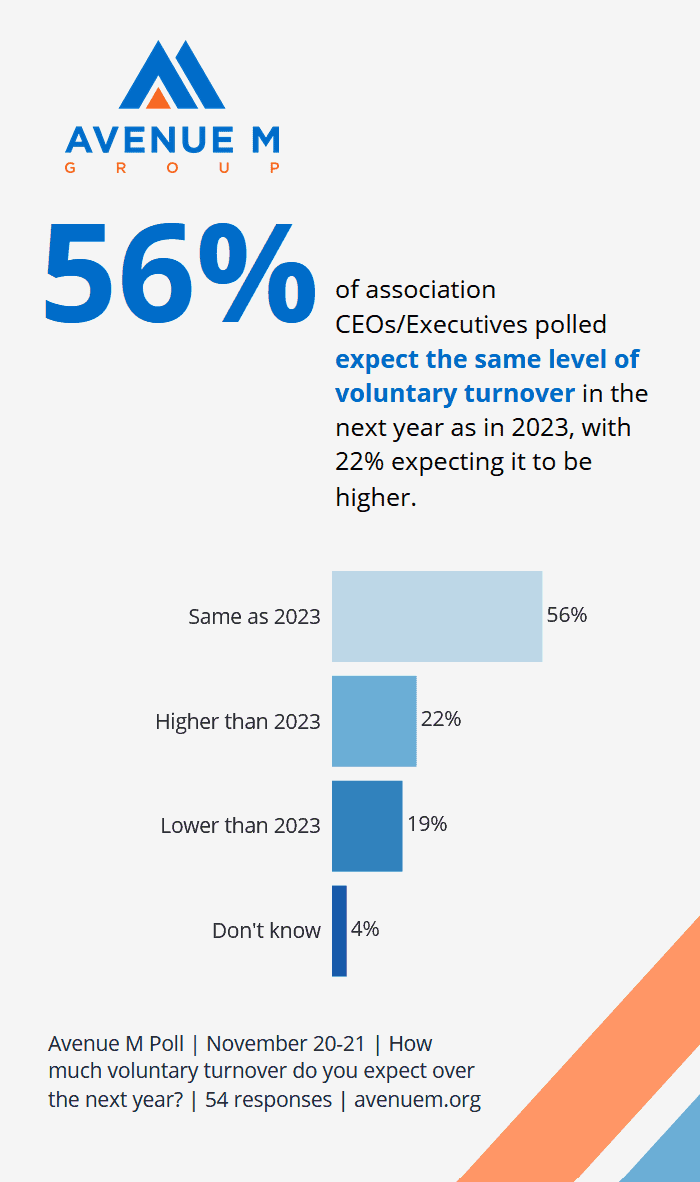Modifications to the workplace spurred by the pandemic have prevailed, and organizations are achieving a level of balance, leading employees to be happier where they are and less inclined to seek other employment opportunities.
The Great Resignation, when record numbers of employees left their jobs during the pandemic, has now shifted to the Big Stay, with workers opting to remain in their jobs.
In September, only 3.7 million Americans—2.3 percent of the workforce—quit their jobs, revealing a consistent decline that matched pre-pandemic levels. At the same time, job openings dropped from 9.2 million in June down to 8.8 million, hitting the lowest point since March 2021, according to the Department of Labor.
 Not surprisingly, associations are in line with that trend. Fifty-six percent of associations said they expect voluntary turnover to remain the same in 2024, 22 percent said it would be higher than 2023, and 19 percent said it would be lower, according to a late-November Avenue M text poll.
Not surprisingly, associations are in line with that trend. Fifty-six percent of associations said they expect voluntary turnover to remain the same in 2024, 22 percent said it would be higher than 2023, and 19 percent said it would be lower, according to a late-November Avenue M text poll.
When asked if they have implemented anything new to attract and keep employees in 2024, one executive who expects things to remain the same said, “No, but we continue to provide flexibility for working from home.”
Another panelist said, “We increased our minimum pay, and formalized the days between Christmas and New Year’s as paid time off.” One leader noted their organization “updated health benefit options, additional time off for volunteering, and a formal ‘buddy program’ for new hires.”
Employees could be staying because they’re spooked by a shakier economy, but it’s more likely that they’re happier where they are. A key driver of the Great Resignation was employees feeling disillusioned with employers who didn’t seem to value or prioritize their needs, which caused them to look elsewhere.
As people began reevaluating what really mattered to them, there was a shift in employee expectations toward work that prompted them to reconsider what they really needed to be satisfied in their professional lives. (Hint: It’s not another cake day).
The good news is—as associations are demonstrating—organizations can bridge the divide between employee desires and organizational needs with relevant offerings like flexible work, professional development, financial incentives that reward loyalty, and well-rounded benefits packages.
These all go a long way in providing employees with an overall sense of security and satisfaction, they help organizations thrive and be even more successful.
Want to participate in future text polls? You can sign up HERE.
For more insights on employee retention and attrition, read Avenue M’s quick summaries of the following resources, and click the links below.
Managing for Employee Retention
Keeping employees motivated and focused is crucial for an organization’s success. A strong retention program helps attract and keep key employees, reducing turnover costs. It’s more effective to retain skilled employees than to find replacements.
Fairness and transparency are key to making employees happy. By focusing on employee retention, companies build a committed and motivated team dedicated to overall success. Key contributors to job satisfaction, as identified in SHRM’s research, include respectful treatment, fair pay, trust in senior management, job security, and using skills.
Four Things Employers Need to Offer to Keep Workers From Quitting
In the post-pandemic work setting, employees want engagement, autonomy, role clarity, and investment from their employers.
- Engagement: feeling valued and heard
- Autonomy: moving beyond fixed office or remote setups
- Role clarity: clear responsibilities, fair compensation for added tasks
- Investment: a commitment to employees’ career growth.
Organizations need to take these expectations seriously, recognizing the shift in employees’ needs post-pandemic.
Companies Need to Normalize Healthy Turnover
Not all employee departures are bad. Planned attrition, where the number of employees decreases intentionally over time, can benefit both employees and employers. For example, McKinsey’s “up and out” approach encourages employees to make the most of their time. This creates a good employer image.
To make planned attrition normal:
- Be clear it’s not forever.
- Focus on promoting internal candidates and rehiring former employees.
- Stay connected with former employees.
Want to be the first to be notified about articles like this? You can learn more about Avenue M’s texting poll service HERE.
Contributors: Sheri Jacobs, FASAE, CAE & Lisa Boylan
Image: Adobe Stock